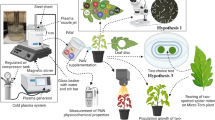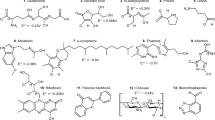Abstract
Proanthocyanidins (PAs) or condensed tannins are a major group of phenolic compounds in the leaves of birch trees and many other woody and herbaceous plants. These compounds constitute a significant allocation of carbon in leaves and are involved in plant responses to environmental stress factors, such as pathogens or herbivores. In some plants, PA concentrations are affected by atmospheric carbon dioxide (CO2) and ozone (O3) levels that may influence, for example, species fitness, community structure, or ecosystem nutrient cycling. Therefore, a study on the quantitative response of PAs to elevated concentrations of carbon dioxide (CO2) and ozone (O3) was undertaken in seedlings of Betula platyphylla, Betula ermanii, and Fagus crenata. Seedlings were exposed to ambient or elevated O3 and CO2 levels during two growing seasons in the Kanto district in Japan. Ten open-top chambers were used for five different treatments with two replicates: filtered air (FA), ambient air (ambient O3, 43 ppb; ambient CO2, 377 ppm), elevated O3 (1.5 × ambient O3, 66 ppb), elevated CO2 (1.5 × ambient CO2, 544 ppm), and elevated O3 and CO2 combined. In addition, seedlings growing in natural conditions outside of chambers were studied. Leaf samples were analyzed for total PA concentrations by butanol–HCl assay and for polymeric PA concentrations by normal-phase high-performance liquid chromatography. Total PA concentrations in leaves of all species were similarly affected by different treatments. They were significantly higher in seedlings treated with elevated CO2 and O3 combined, and in seedlings growing outside chambers compared with the FA controls. F. crenata contained only traces of polymeric PAs, but significant species × treatment interaction was observed in the polymeric PA concentrations in B. ermanii and B. platyphylla. In B. platyphylla, leaves treated with elevated CO2 + O3 differed significantly from all other treatments. It was suggested that the strongest effect of elevated CO2 and O3 combined on leaf PA contents resulted from the additive effect of these environmental factors on phenolic biosynthesis.


Similar content being viewed by others
References
Booker, F. L. 2000. Influence of carbon dioxide enrichment, ozone, and nitrogen fertilization on cotton (Gossypium hirsutum L.) leaf and root composition. Plant Cell Environ. 23:573–583.
Booker, F. L. and Maier, C. A. 2001. Atmospheric carbon dioxide, irrigation, and fertilization effects on phenolic and nitrogen concentrations in loblolly pine (Pinus taeda L.) needles. Tree Physiol. 21:609–619.
Booker, F. L. and Miller, J. E. 1998. Phenylpropanoid metabolism and phenolic composition of soybean [Glycine max (L.) Merr.] leaves following exposure to ozone. J. Exp. Bot. 49:1191–1202.
Booker, F. L., Anttonen, S., and Heagle, A. S. 1996. Catechin, proanthocyanidin and lignin contents of loblolly pine (Pinus taeda) needles after chronic exposure to ozone. New Phytol. 132:483–492.
Booker, F. L., Shafer, S. R., Wei, C.-M., and Horton, S. J. 2000. Carbon dioxide enrichment and nitrogen fertilization effects on cotton (Gossypium hirsutum L.) plant residue chemistry and decomposition. Plant Soil 220:89–98.
Booker, F. L., Prior, S. A. Torbert, H. A., Fiscus, E. L., Pursley, W. A., and Hu, S. 2005. Decomposition of soybean grown under elevated concentrations of CO2 and O3. Glob. Chang. Biol. 11:685–698.
Carter, E. B., Theodorou, M. K., and Morris P. 1999. Responses of Lotus corniculatus to environmental change. 2. Effect of elevated CO2, temperature and drought on tissue digestion in relation to condensed tannin and carbohydrate accumulation. J. Sci. Food Agric. 79:1431–1440.
Darral, N. M. 1989. The effect of air pollutants on physiological processes in plants. Plant Cell Environ. 12:1–30.
Eckey-Kaltenbach, H., Ernst D., Heller, D., and Sandermann, H. 1994. Biochemical plant responses to ozone. IV. Cross-induction of defensive pathways in parsley (Petroselinum crispum L.) plants. Plant Physiol. 104:67–74.
Entry, J. A., Runion, G. B., Prior, S. A., Mitchell, R. J., and Rogers, H. H. 1998. Influence of CO2 enrichment and nitrogen fertilization on tissue chemistry and carbon allocation in longleaf pine seedlings. Plant Soil 200:3–11.
Fuhrer, J. and Booker, F. 2003. Ecological issues related to ozone: Agricultural issues. Environ. Int. 29:141–154.
Gebauer, R. L. E., Strain, B., and Reynolds, J. F. 1998. The effect of elevated CO2 and N availability on tissue concentrations and whole plant pools of carbon-based secondary compounds in loblolly pine (Pinus taeda). Oecologia 113:29–36.
Haslam, E. 1988. Plant polyphenols (syn. vegetable tannins) and chemical defense—a reappraisal. J. Chem. Ecol. 14:1789–1805.
Henriksson, J., Haukioja, E., Ossipov, V., Ossipova, S., Sillanpää, S., Kapari, L. M., and Pihlaja, K. 2003. Effects of host shading on consumption and growth of the geometrid Epirrita autumnata: interactive roles of water, primary and secondary metabolites. Oikos 103:3–16.
Herms, D. A. and Mattson, W. J. 1992. The dilemma of plants: to grow or defend. Q. Rev. Biol. 67:283–335.
IPCC Climate Change 2001: The Scientific Basis (Report of Working Group of the Intergovernmental Panel on Climate Change, IPCC, Secretariat, Geneva, 2001). http://www.ipcc.ch/pub/spm22-01.pdf.
Jordan, D. N., Green, T. H., Chappelka, A. H., Lockaby, B. G., Meldahl, R. S., and Gjerstad, D. H. 1991. Response of total tannins and phenolics in loblolly pine foliage exposed to ozone and acid rain. J. Chem. Ecol. 17:505–513.
Julkunen-Tiitto, R., Tahvanainen, J., and Silvola, J. 1993. Increased CO2 and nutrient status changes affect phytomass and the production of plant defensive secondary chemicals in Salix myrsinolia (Salisb.). Oecologia 95:495–498.
Kangasjärvi, J., Talvinen, J., Utriainen, M., and Karjalainen, R. 1994. Plant defence systems induced by ozone. Plant Cell Environ. 17:783–794.
Karonen, M., Loponen, J., Ossipov, V., and Pihlaja, K. 2004. Analysis of procyanidins in pine bark with reversed-phase and normal-phase high-performance liquid chromatography–electrospray ionization mass spectrometry. Anal. Chim. Acta 522:105–112.
Karonen, M., Ossipov, V., Sinkkonen, J., Loponen, J., Haukioja, E., and Pihlaja, K. 2006. Quantitative analysis of polymeric proanthocyanidins in birch leaves with normal-phase HPLC. Phytochem. Anal. (in press).
Kause, A., Ossipov, V., Haukioja, E., Lempa, K., Hanhimäki, S., and Ossipova, S. 1999. Multiplicity of biochemical factors determining quality of growing birch leaves. Oecologia 120:102–112.
Kinney, K. K., Lindroth, R. L., Jung, S. M., and Nordheim, E. V. 1997. Effects of CO2 and NO3 − availability on deciduous trees: phytochemistry and insect performance. Ecology 78:215–230.
Kuokkanen, K., Yan, S., and Niemelä, P. 2003. Effects of elevated CO2 and temperature on the leaf chemistry of birch Betula pendula (Roth) and the feeding behaviour of the weevil Phyllobius maculicornis. Agric. For. Entomol. 5:209–217.
Lavola, A., Julkunen-Tiitto, R., and Pääkkönen, E. 1994. Does ozone stress change the primary or secondary metabolites of birch (Betula pendula Roth.)? New Phytol. 126:637–642.
Lavola, A., Julkunen-Tiitto, R., De La Rosa, T. M., Lehto, T., and Aphalo, P. J. 2000. Allocation of carbon to growth and secondary metabolites in birch seedlings under UV-B radiation and CO2 exposure. Physiol. Plant. 109:260–267.
Lawler, L. R., Foley, W. J., Woodrow, I. E., and Cork, S. J. 1997. The effects of elevated CO2 atmospheres on the nutritional quality of Eugalyptus foliage and its interaction with soil nutrient and light availability. Oecologia 109:59–68.
Lindroth, R. L., Kinney, K. K., and Platz, C. L. 1993. Responses of deciduous trees to elevated atmospheric CO2: productivity, phytochemistry, and insect performance. Ecology 74:763–777.
Lindroth, R. L., Kopper, B. J., Parsons, W. F. J., Bockheim, J. G., Karnosky, D. F., Hendrey, G. R., Pregitzer, K. S., Isebrands, J. G., and Sober, J. 2001. Consequences of elevated carbon dioxide and ozone for foliar chemical composition and dynamics in trembling aspen (Populus tremuloides) and paper birch (Betula papyrifera). Environ. Pollut. 115:395–404.
Manning, W. J. and Tiedemann, A. V. 1995. Climate change: potential effects of increased atmospheric carbon dioxide (CO2), ozone (O3), and ultraviolet-B (UV-B) radiation on plant diseases. Environ. Pollut. 88:219–245.
Matsumura, H., Mikami, C., Sakai, Y., Murayama, K., Izuta, T., Yonekura, T., Miwa, M., and Kohno, Y. 2005. Impacts of elevated O3 and/or CO2 on growth of Betula platyphylla, Betula ermanii, Fagus crenata, Pinus densiflora and Cryptomeria japonica seedlings. J. Agric. Meteorol. 60:1121–1124.
Ossipov, V., Haukioja, E., Ossipova, S., Hanhimäki, S., and Pihlaja, K. 2001. Phenolic and phenolic-related factors as determinants of suitability of mountain birch leaves to an herbivorous insect. Biochem. Syst. Ecol. 29:223–240.
Ossipova, S., Ossipov, V., Haukioja, E., Loponen, J., and Pihlaja, K. 2001. Proanthocyanidins of mountain birch leaves: quantification and properties. Phytochem. Anal. 12:128–133.
Porter, L. J., Hrstich, L. N., and Chan, B. G. 1986. The conversion of procyanidins and prodelphinidins to cyanidin and delphinidin. Phytochemistry 25:223–230.
Rao, M. V., Hyung-Il, L., Creelman, R. A., Mullet, J. E., and Davis, K. R. 2000. Jasmonic acid signaling modulates ozone-induced hypersensitive cell death. Plant Cell 12:1633–1646.
Reich, P. B. 1983. Effects of low concentrations of O3 on net photosynthesis, dark respiration, and chlorophyll contents in aging hybrid poplar leaves. Plant Physiol. 73:291–296.
Reich, P. B. 1987. Quantifying plant response to ozone: a unifying theory. Tree Physiol. 3:63–91.
Rohr, G. E. 2002. Analysis of proanthocyanidins, pp. 60–97, in S. Martens, D. Treutter, G. Forkmann (eds.). Polyphenols 2000. Freising.
Scalbert, A. 1992. Quantitative methods for the estimation of tannins in plant tissue, pp. 259–280, in R. W. Hemingway, P. E. Laks (eds.). Plant Polyphenols, Plenum Press, New York.
Schofield, P., Mbugua, D. M., and Pell, A. N. 2001. Analysis of condensed tannins: a review. Anim. Feed Sci. Technol. 91:21–40.
Traw, M. B., Lindroth, R. L., and Bazzaz F. A. 1996. Decline in gypsy moth (Lymantria dispar) performance in an elevated CO2 atmosphere depends upon host plant species. Oecologia 108:113–120.
Waterman, P. G. and Mole, S. 1994. Analysis of Phenolic Plant Metabolites, pp. 92–98, Blackwell Scientific Publications, Oxford.
Acknowledgment
This research was funded by the Academy of Finland (project number 201073 for V.O.).
Author information
Authors and Affiliations
Corresponding author
Rights and permissions
About this article
Cite this article
Karonen, M., Ossipov, V., Ossipova, S. et al. Effects of Elevated Carbon Dioxide and Ozone on Foliar Proanthocyanidins in Betula platyphylla, Betula ermanii, and Fagus crenata Seedlings. J Chem Ecol 32, 1445–1458 (2006). https://doi.org/10.1007/s10886-006-9061-8
Received:
Revised:
Accepted:
Published:
Issue Date:
DOI: https://doi.org/10.1007/s10886-006-9061-8




